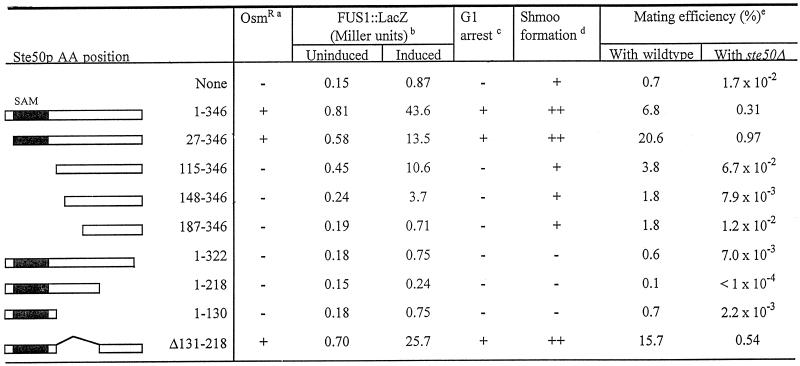Table 2.
Functional domains of Ste50p
a The hyperosmolarity-resistant phenotype of yeast cells YCW365 (ssk2Δ ssk22Δ ste50Δ) transformed with different STE50 alleles was scored for growth (+) on selective media with 1.5 M sorbitol after 4 d at 30°C.
β-galactosidase activity was determined with yeast cells of YCW335 (ste50Δ::TRP1 sst1::hisG FUS1::LacZ::LEU2) transformed with different alleles of STE50, either treated with 1 μM of α-factor (induced) or not (uninduced) for 1.5 h, and the activity was expressed as Miller units (see MATERIALS AND METHODS). Data represent the mean value of two to three independent experiments (the estimate of the error for each value was < 25% of the mean value).
Cell cycle arrest was assessed with yeast cells as in noteb for their ability to arrest (+) on selective media with 1 μM of α-factor after a 24 h incubation at 30°C.
Yeast cells as in noteb were treated with 1 μM α-factor, and times required for shmoo formation were determined. ++ indicates shmoo formation within 2 h after α-factor treatment, + indicates shmoo formation 5 h after the treatment, and − indicates no shmoo formation after 8 h.
Mating was performed by mixing exponentially growing cells of YCW315 (ste50Δ) bearing different alleles of STE50 with fivefold excess of tester cells of either DC17 (his1) or YCW316 (ste50Δ) and incubating for 4 h at 30°C (MATERIALS AND METHODS). Mating efficiency was defined as (the number of diploid cells)/(the number of the experimental haploid cells) × 100. Data represent the mean of two to three independent experiments.

